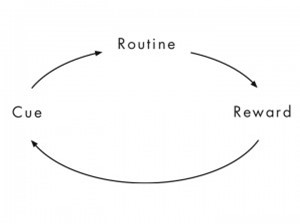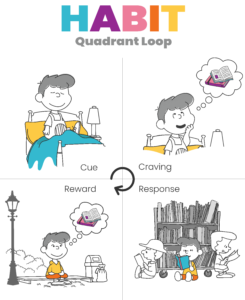
By now you probably have a solid understanding of our focus. How do we make tiny but powerful interventions in the development of our children’s First Habits? By making these small shifts in mental perspective and habit we can change the trajectory of their development and help them shift into an upward spiral and an environment where learning is easier and the struggles that poor habits create are minimized.
The Power of Habits: Understanding the Loop and Its Impact on Development
We’re not promising an overnight transformation here. We want to be very clear about that, but we all know the immense power that habits have on our lives. If we really think about it, we all wish we had a way to go back and replace some of our bad habits – procrastination, poor sleeping routines, frustration rather than proactivity, eating low quality foods, etc. – with better and more optimized habits.
It’s also the case that we’ve developed many habits that we don’t even realize are not ideal. We’ve already talked about nasal breathing and the importance of creating that First Habit from the very beginning of your child’s life. This is a completely overlooked First Habit. Similarly, many of the habits that we’ll explore together might seem like brand new ways of learning and some will likely not be what you would have taught your child. This is perfectly okay. But research has come a long way since we were growing up and there are always new and improved findings which we can positively apply to our children’s lives.
While most bad habits can be corrected with time and attention later in life, there are certain behaviors like nasal breathing in contrast to mouth breathing that can create lasting and profound impacts on our overall levels of health, success and happiness. That’s one reason why we highlighted nasal breathing at the beginning of our journey.
Exploring the Loop: Cue, Routine, Reward, and the Formation of First Habits
You might be asking yourself – okay I agree with the premise that First Habits are important in my child’s development and there are several effective parenting strategies that I should focus on, but how do I create these habits in my children and what type of nudges and adjustments are going to create a First Habit? And that’s exactly what we are going to jump into right now.
What do we know about effective habit formation? There are so many different aspects to this research, but let’s go through what’s important and actionable for you as parents. First of all, every individual is different and every habit is different so while there’s a general framework for developing or breaking a habit, the steps you employ to develop a good sleep routine for your child is going to be much different than a tactic you might use to improve creative thinking at school. However, knowing what the research teaches us about habits, there are some very base level precepts that apply to just about every habitualized experience.
All of what we have learned about habits comes from a growing body of quality research, including two bestselling books: The Power of Habit by Charles Duhigg and Atomic Habits by James Clear. Both of which are amazing reads and improve our understanding of habits, habit formation and how best to impart positive First Habits to our children.
First let’s take a look at The Power of Habit:
- As compared to Atomic Habits, this is more of a formulaic view of habits and why they are important and how they are structured.
- Habits are driven in large part by evolution. If your brain had to be 100% conscious and cognizant of every behavior or action every minute of every day that would be a huge drain on your body’s energy and resources.
- Think about driving a car. At some point you just drive the car and don’t need to be fully locked in and focused. Contrast that with your first time driving a car – adrenaline pumping and completely locked in with little ability to focus on anything else. The evolution of habit is positive for both brain and body.
- The negative part of habits is that once a habit is internalized and ingrained, it can be very hard to break out of the loop. This is something that all of us have struggled with. There’s a reason why each of our negative habits developed. They might sprout from stress or unhappiness or a need for organization. Whatever the habit, with enough examination, you can usually find the source of the habit which if often called a “cue.”
- Duhigg breaks down all of habits and habit formation into a loop which becomes self-reinforcing. There’s initially a cue, then a routine (which effectively is the habit) and then some reward. The diagram below shows this loop:
- For example, the cue to watch TV after a long day at work is stepping in the door and feeling tired. The TV goes on and the reward is zoning out at the end of a long day and the feeling that goes along with that. Then the next day that reward is craved by the body and the loop is reinforced.
- Using the above loop will allow us to either reinforce the positive behavior that we see in our children or adjust it to make sure that bad habits don’t develop.
- The book goes into a ton of other detail about how to adjust routines and sub in other cues that will be the focus of our future content.
Atomic Habits: The Four-Part Guide to Creating Positive Habits for Children
So now that we understand a very base level of habit formation and habit loops, let’s quickly summarize the Atomic Habits book.
- In this book, the author expands the three-part habit loop to include “craving” between “cue” and “routine.” This is an interesting observation because we all know that craving is one of the key aspects of any strong habit. There needs to be that impetus that compels you to do the habit to then get the reward. Please reference the below habit loop for a child starting to read every day when they wake up.
- The most important framework from the book is the author’s four-part guide to creating a positive habit:
- The 1st law (Cue): Make it obvious.
- The 2nd law (Craving): Make it attractive.
- The 3rd law (Response): Make it easy.
- The 4th law (Reward): Make it satisfying.
- And the inverse for breaking a bad habit:
- Inversion of the 1st law (Cue): Make it invisible.
- Inversion of the 2nd law (Craving): Make it unattractive.
- Inversion of the 3rd law (Response): Make it difficult.
- Inversion of the 4th law (Reward): Make it unsatisfying.
- Let’s now think through the good habit framework and how we can create First Habits in our children.
- Any time you are trying to promote a habit, you should leave something in a very visible part of your home (make it obvious) that reminds you and your child of the First Habit.
- After they are in the process of doing the positive habit, you make sure they are comfortable and have everything they need to feel secure (make it attractive).
- At the same time, take away any barriers that might stimulate an objection from your child (make it easy).
- Once the behavior is complete, provide a reward for that behavior (make it satisfying).
- Now this one is a little tricky because we want the habit to be self-reinforcing and intrinsically motivated. We don’t want our children only doing something because they think they are going to get extra dessert. That can backfire spectacularly as we’re all aware. We’ll delve deep into the internal / external motivation question, but for now let’s just say that a habit loop requires some form of “reward” which can be almost anything and doesn’t need to fit the traditional way of thinking that a reward needs to be either praise from a parent or a food that the child likes, etc.
- One other point that the author makes multiple times in the book is that goal setting can at times be a fool’s errand. It is much more important to focus on habits and processes because they will dictate the repeatable behaviors that come to define our lives. These processes will also form the core baseline of whether you and your child are on the upward spiral or downward spiral.
So that’s where we’ll leave it for now. There’s still a tremendous amount of ground to cover, but as you start learning about the high-value First Habits that will be so important to your child’s development, we encourage you to use the above mental model of habit formation to ensure that whatever you teach your child has a higher chance of “sticking” and becoming a First Habit and therefore have more of a positive impact on their lives.









